International Models Of Corporate Governance

Photo by Loeng Lig on Unsplash
Corporate governance involves balancing the interests of various stakeholders to ensure that a company is able to survive and grow over the long term. Governance systems vary significantly from country to country, leading to different outcomes for various constituencies. For instance, stakeholder-oriented approaches may benefit employees and consumers, while shareholder-oriented systems may offer distinct advantages to investors. These differences can have far-reaching implications for how businesses are operated and governed, affecting everything from shareholder returns to corporate social responsibility.
This article aims to explore the diverse models of corporate governance across selected jurisdictions. We’ll explore a high-level overview of each country’s unique system, including key attributes and norms. Studying and comparing these different systems of governance can provide useful insights into how various models influence corporate performance and economic growth. My goal is to further your understanding of these dynamics so you can make better-informed decisions as an investor or business leader. Please check the References section at the end for additional resources.
The United States
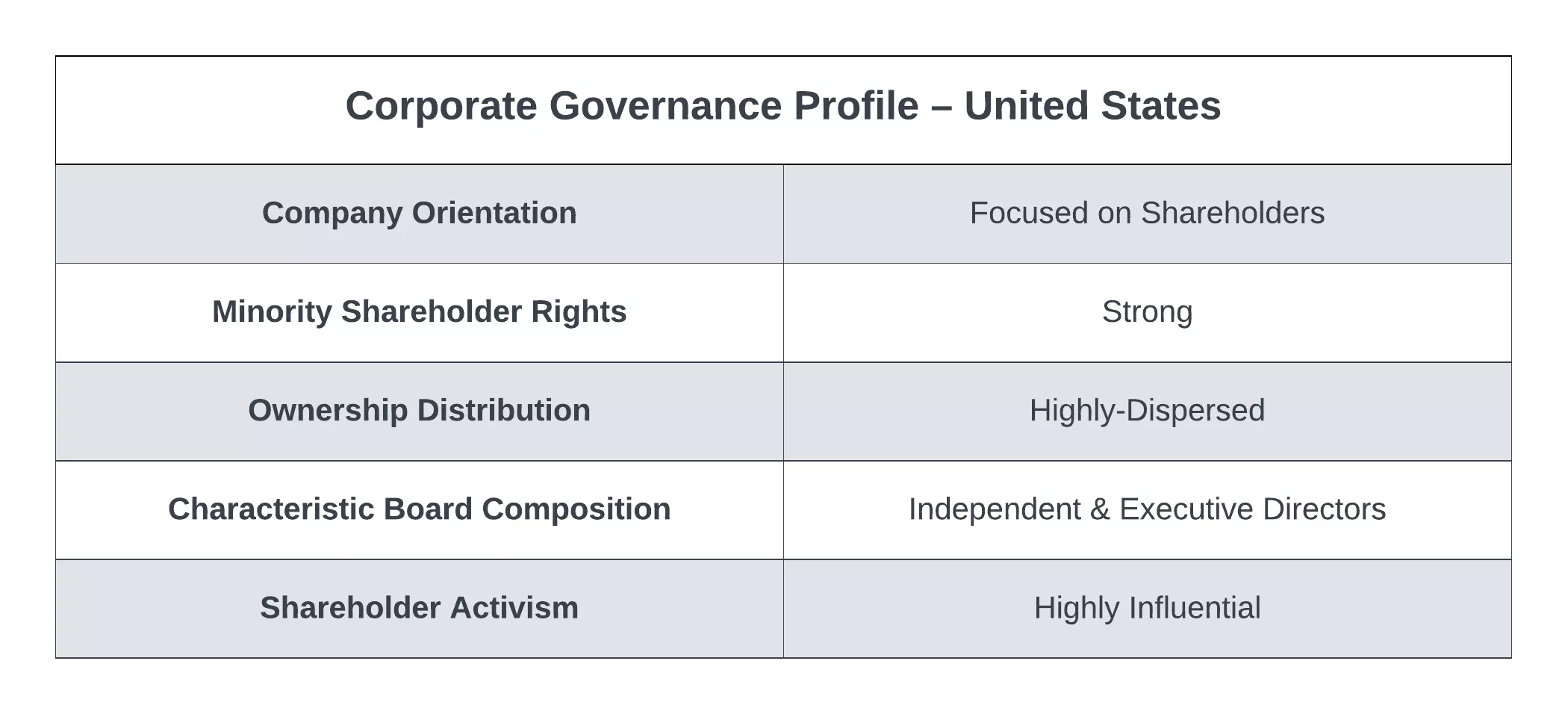
The United States employs a unique model of corporate governance, characterized by a variety of legal, regulatory, board-related, shareholder, and stakeholder attributes. This model has evolved over the years to meet the challenges posed by an ever-evolving business and regulatory landscape, while upholding the principles of transparency, accountability, and corporate responsibility.
The U.S. operates under a common law system where corporate governance is primarily regulated at the state level, with Delaware law exerting significant influence due to a large number of corporations being incorporated there. The regulatory environment includes key players like the Securities and Exchange Commission (SEC) and the Financial Accounting Standards Board (FASB). The SEC’s Corporate Finance division enforces federal securities laws and regulations aimed at promoting disclosure and transparency. The role of auditors is substantial, ensuring that companies comply with established accounting standards, including Generally Accepted Accounting Principles (GAAP). Independent external audit firms are required, providing an additional layer of financial scrutiny and integrity. Stock exchanges, such as the NYSE, also provide guidance on corporate governance matters.
In the U.S., most corporations operate under a unitary board structure composed of both executive and non-executive (independent) directors. It is common, though decreasingly so, for the roles of Chairman and CEO to be combined. Board composition has become increasingly diverse, both in terms of expertise and social background. Disclosure and transparency are heavily emphasized, with detailed financial reporting requirements set out by the SEC. Corporations are expected to establish explicit policies to handle potential conflicts of interest among board members and executives.
Shareholders in U.S. corporations enjoy strong rights. Voting rights are typically proportional to share ownership, allowing shareholders to vote on major corporate decisions. However, a significant proportion of public companies, particularly in the technology sector, are making use of dual-class share structures that disenfranchise common shareholders. The U.S. also has a highly-dispersed ownership structure, with many individual and institutional investors holding stakes in corporations. The role of financial intermediaries and proxy advisors is prominent in guiding shareholder voting decisions, with asset managers and fund providers playing a substantial role. The market for corporate control is active, with a regulatory framework that facilitates but also carefully scrutinizes mergers and acquisitions. Protections for minority shareholders are robust, ensuring fair treatment and preventing abuses by majority shareholders.
The U.S. model places a strong emphasis on maximizing shareholder value, but stakeholder considerations are gaining increased attention. This is partly driven by evolving societal expectations and partly due to changing regulations. Employee representation on boards is not mandated so the influence of labor organization is somewhat diminished. Executive compensation is a high-profile issue; it is largely performance-based and frequently subject to public scrutiny and advisory votes by shareholders. The U.S. is unique in its use of equity-based compensation, which is much more prevalent in the U.S. than in other countries. Consumer rights (especially privacy rights) have become a growing concern, although much regulation in this area comes at the state, rather than the federal level. The California Consumer Privacy Act (CCPA) is perhaps the most prominent example of consumer privacy law in the U.S.
The United Kingdom
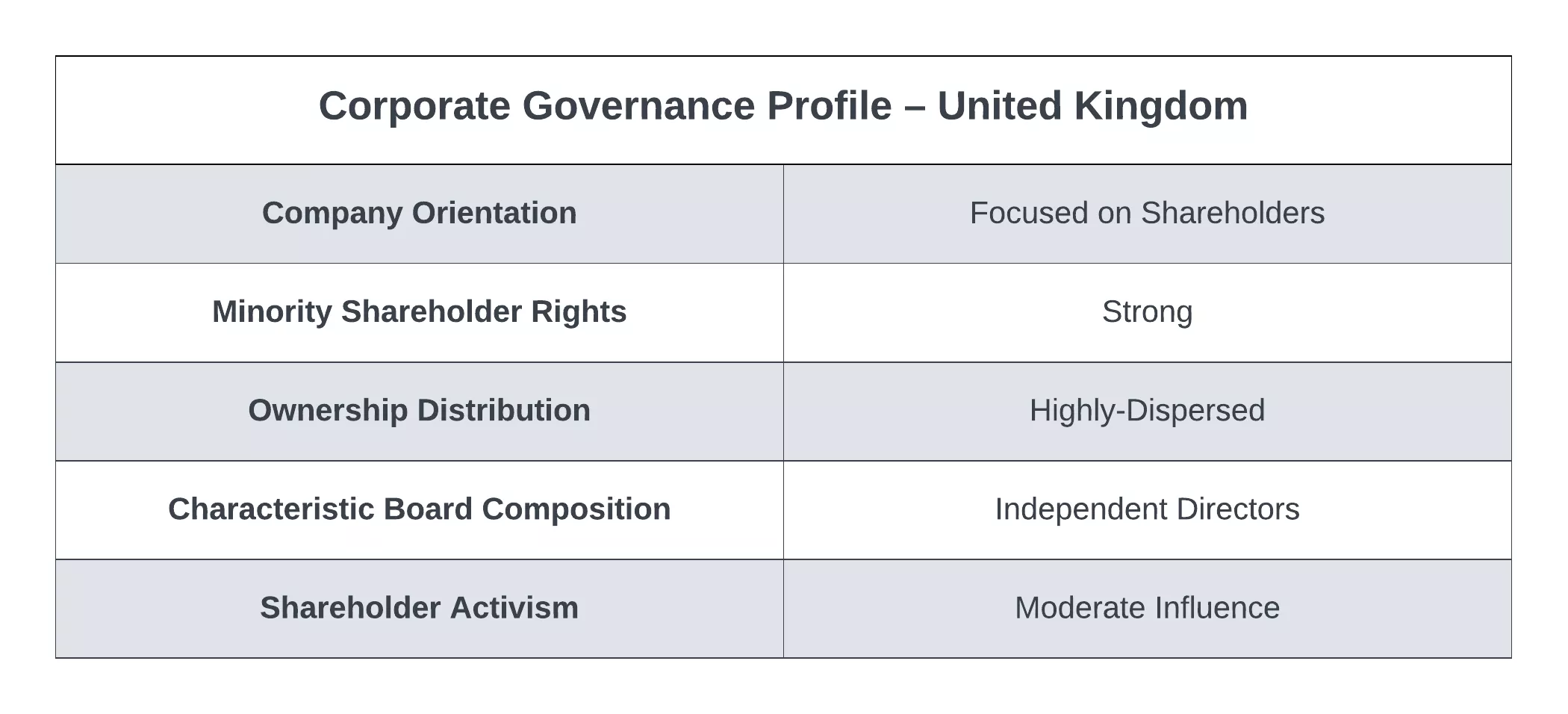
The corporate governance model of the United Kingdom has been highly influential in shaping the corporate structures and practices of many countries, particularly those within the Commonwealth. It stands out due to its strong emphasis on shareholder rights, a robust regulatory environment, and a continuous push towards greater transparency and accountability.
Operating under a common law system, UK corporate governance is primarily influenced by the Companies Act 2006 and the UK Corporate Governance Code. The Financial Reporting Council (FRC) is the key regulator, setting the UK Corporate Governance Code, which operates on a 'comply or explain' basis. Auditing practices uphold the integrity of financial statements, and auditors are expected to provide independent assurance of financial reporting. Accounting standards are enforced by the FRC, with UK companies generally adhering to the International Financial Reporting Standards (IFRS).
The UK generally adopts a unitary board structure, comprising executive and non-executive directors. Increasingly, there is a trend towards separating the roles of the Chairman and the CEO to avoid concentration of power. The board composition encourages diversity, with the UK Corporate Governance Code advocating a balance of skills, experiences, and knowledge. The Code also mandates comprehensive disclosures to promote transparency, and it includes clear guidelines on managing conflicts of interest among board members.
Shareholders in the UK enjoy substantial rights, with voting rights generally proportional to their shareholdings. The ownership structure tends to be more dispersed, akin to the U.S. model. Financial intermediaries and proxy advisors play a significant role in the governance structure, with institutional investors acting as stewards for the corporation. The UK has an active market for corporate control, with mergers and acquisitions regulated by the Takeover Panel. The rights of minority shareholders are well-protected by the Companies Act, ensuring their fair treatment.
The UK model, traditionally shareholder-oriented, has begun to incorporate more stakeholder considerations. While there is no statutory requirement for employee representation on boards, the UK Corporate Governance Code encourages boards to engage with employees. Executive compensation is a key area of focus and is subject to annual advisory or binding votes by shareholders. Lastly, consumer rights, including privacy rights, are protected under various legislations, including the Data Protection Act 2018, which enforces GDPR regulations within the UK.
Germany
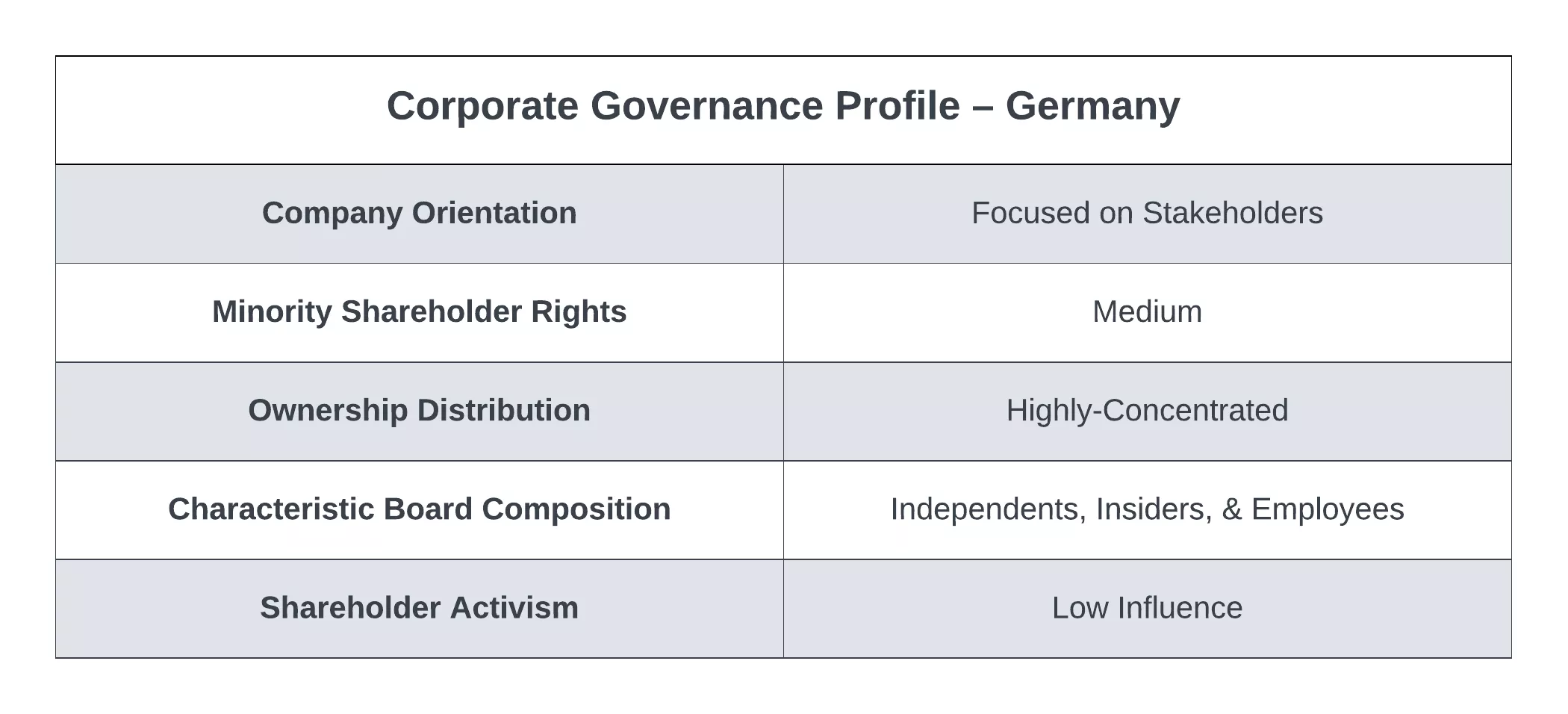
Germany's model of corporate governance is known for its stakeholder-oriented approach. The German model places significant emphasis on the role of employees to balance the interests of shareholders.
Germany operates under a civil law system, with its corporate governance largely determined by the German Stock Corporation Act (Aktiengesetz) and the German Corporate Governance Code. Regulatory oversight is provided by the Federal Financial Supervisory Authority (BaFin). Auditing practices, crucial for ensuring the veracity of financial statements, are strictly regulated, with an emphasis on auditor independence. Accounting standards follow International Financial Reporting Standards (IFRS), as adopted by the European Union.
German corporations typically have a two-tier board structure comprising a management board (Vorstand) and a supervisory board (Aufsichtsrat), ensuring a clear distinction between management and oversight functions. The management board is responsible for running the business, while the supervisory board appoints, supervises, and advises the management board. Disclosure requirements are comprehensive, and companies are required to manage and disclose any conflicts of interest.
Shareholder rights in Germany are protected, but the emphasis on a stakeholder approach mitigates shareholder influence. Voting rights are proportional to share ownership. However, ownership is highly-concentrated with significant holdings by banks, prominent families, and the state. The role of financial intermediaries and proxy advisors, although present, is not as pronounced as in the US or the UK. The market for corporate control is regulated, with substantial protections for minority shareholders in the event of takeovers. For instance, the thresholds for shareholders to approve M&A transactions are quite high, reaching 95% for squeeze-out resolutions.
In the German stakeholder-oriented model, the interests of employees, customers, and the community at large carry significant weight. A notable feature is codetermination (Mitbestimmung), which mandates employee representation on the supervisory board, fostering cooperation between management and workers. Executive compensation is regulated and has generally been less excessive compared to countries like the US. Consumer rights, including privacy, are robustly protected under the German Federal Data Protection Act and other EU laws.
France
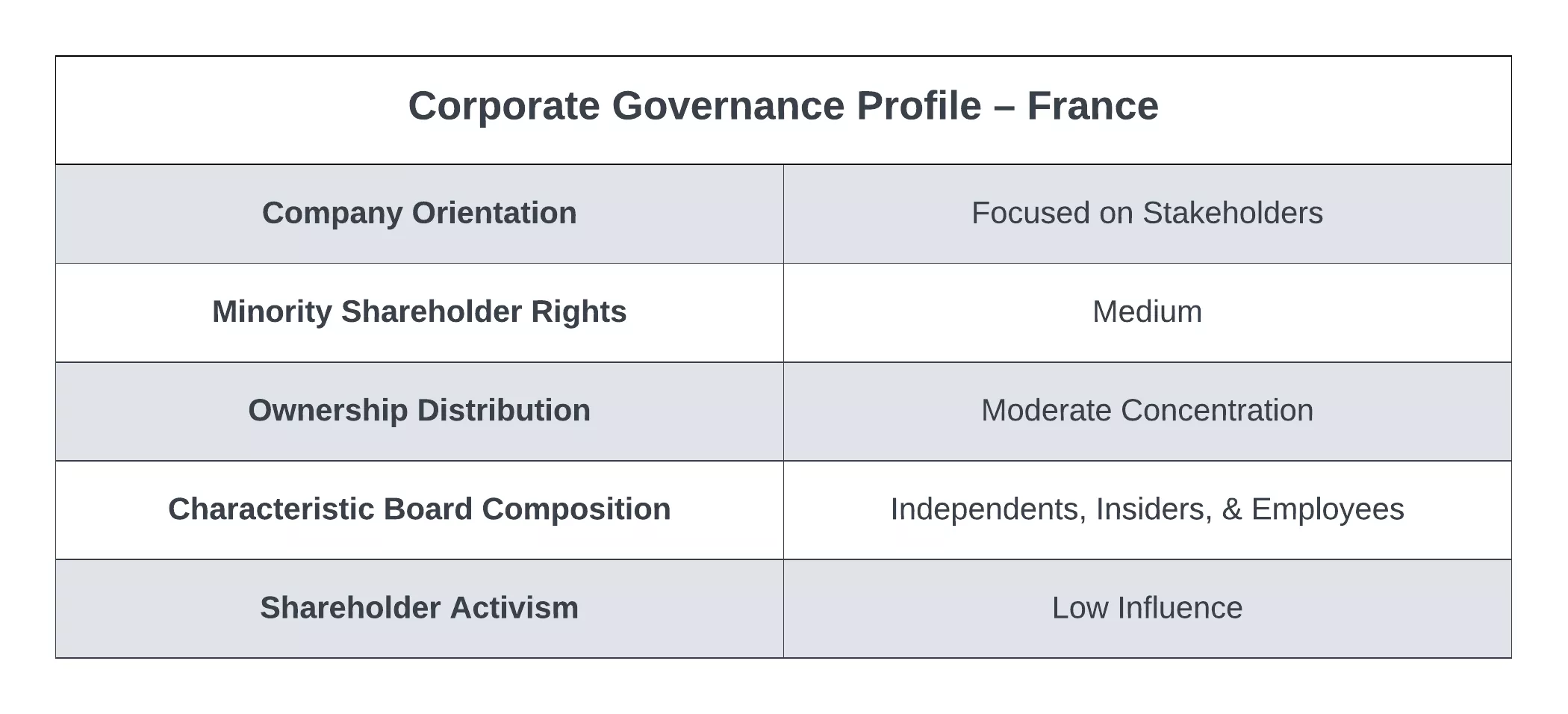
France's corporate governance model is a distinctive blend of continental European and Anglo-Saxon influences. Over the years, the French model has evolved, integrating stronger shareholder rights, increased board independence, and greater transparency, while maintaining its characteristic stakeholder-oriented approach.
Operating under a civil law system, French corporate governance is primarily influenced by the French Commercial Code and the recommendations of the French Corporate Governance Code (Afep-MEDEF). The Autorité des Marchés Financiers (AMF) is the primary regulator, overseeing transparency and compliance with governance rules. Auditing practices are stringent, with two auditors typically required for public companies. French companies listed on the stock exchange follow International Financial Reporting Standards (IFRS).
France offers corporations the choice between a one-tier (Board of Directors) and a two-tier board (Supervisory Board and Management Board), but most opt for the one-tier system. The roles of Chairman and CEO can be combined or separated, but there is a trend towards separation. Board diversity is strongly promoted, with gender equality rules requiring women to comprise at least 40% of large company boards. Companies are required to provide detailed financial disclosures and manage and disclose any conflicts of interest among board members. Censors may also join board meetings in a non-voting, observational capacity to provide their expertise.
French law confers significant rights on shareholders. Voting rights are proportional to ownership, but extra voting rights can be awarded to long-term shareholders (tenure voting). The ownership structure is generally concentrated, and the government directly owns equity stakes in a fair number of French companies. Financial intermediaries and proxy advisors play an important role, although institutional investors are less prominent in France than in the U.S. or UK. The market for corporate control is active, although takeovers are subject to great scrutiny. Hostile bids are relatively uncommon, with only a handful of such bids being proposed in the past decade. Minority shareholders enjoy strong protection under French law.
The French model traditionally leans towards a stakeholder orientation. Employee representation on the board is mandatory for larger companies, reflecting the importance France places on the voice of employees in corporate governance. Executive compensation is regulated, with shareholders having a binding say on pay (as opposed to advisory votes in the U.S.). Furthermore, consumer rights are robustly protected, with privacy rights gaining increased attention due to regulations such as the EU's General Data Protection Regulation (GDPR).
Switzerland
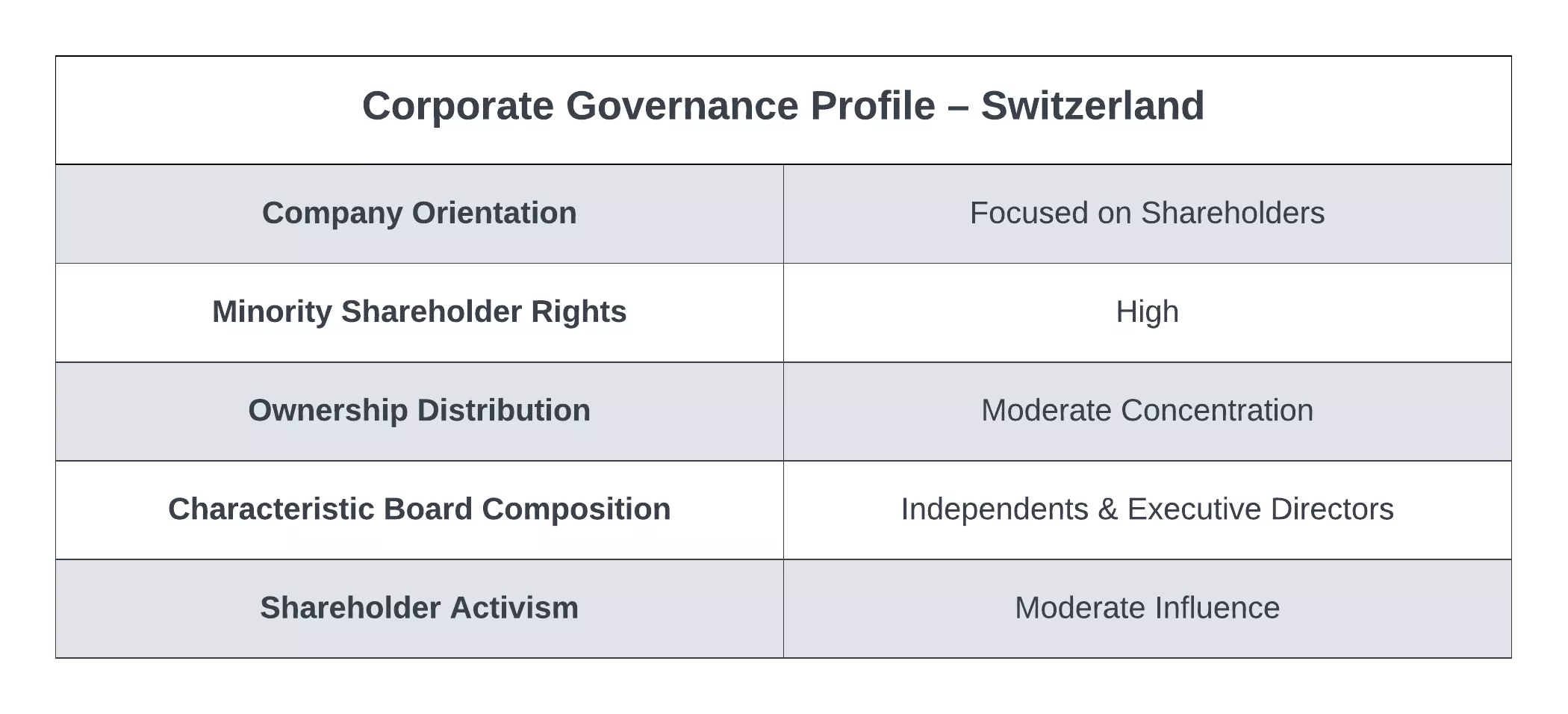
Switzerland's corporate governance model is notable for its flexibility and focus on shareholder rights. Known for its neutrality and stability, Switzerland presents a unique approach to corporate governance, balancing the needs of shareholders with those of other stakeholders.
Under its civil law system, Switzerland's corporate governance is primarily governed by the Swiss Code of Obligations. The key regulator is the Swiss Financial Market Supervisory Authority (FINMA), which oversees financial institutions and ensures market conduct rules. Auditing is mandatory for all Swiss companies, and its practice follows the Swiss GAAP FER or International Financial Reporting Standards (IFRS), depending on the company's size and whether it is publicly traded. Switzerland also bears the Swiss Best Practices on Corporate Governance, which is supported by a number of notable industry associations.
Swiss corporations typically operate with a single-tier board system. The role of the Chairman is often separated from the CEO, avoiding an excessive concentration of power. Diversity on the board is encouraged but not legally mandated. Comprehensive disclosures are required, with clear rules on managing and disclosing potential conflicts of interest among board members.
Swiss law highly values the rights of shareholders. Voting rights are generally one share, one vote, and shareholders have significant say on important matters, such as electing board members. The ownership structure can be quite dispersed, particularly for large public companies. Financial intermediaries and proxy advisors play a vital role in the Swiss model, advising shareholders on various matters. The market for corporate control is fairly active, with mergers and acquisitions regulated to ensure fair and transparent procedures. Minority shareholders enjoy significant protection under Swiss law.
While the Swiss model is more shareholder-oriented, it acknowledges the importance of other stakeholders. Employee representation at the board level is not mandatory, but their interests are considered in decision-making. Executive compensation has been a focus of recent corporate governance reforms, with a major initiative, the Minder Initiative, giving shareholders a binding vote on executive pay. Like most other jurisdictions, Swiss shareholders are not required to vote their shares, although institutional investors face increased pressure to participate responsibly. Consumer rights are taken seriously, with privacy rights underscored by strict data protection laws.
Japan
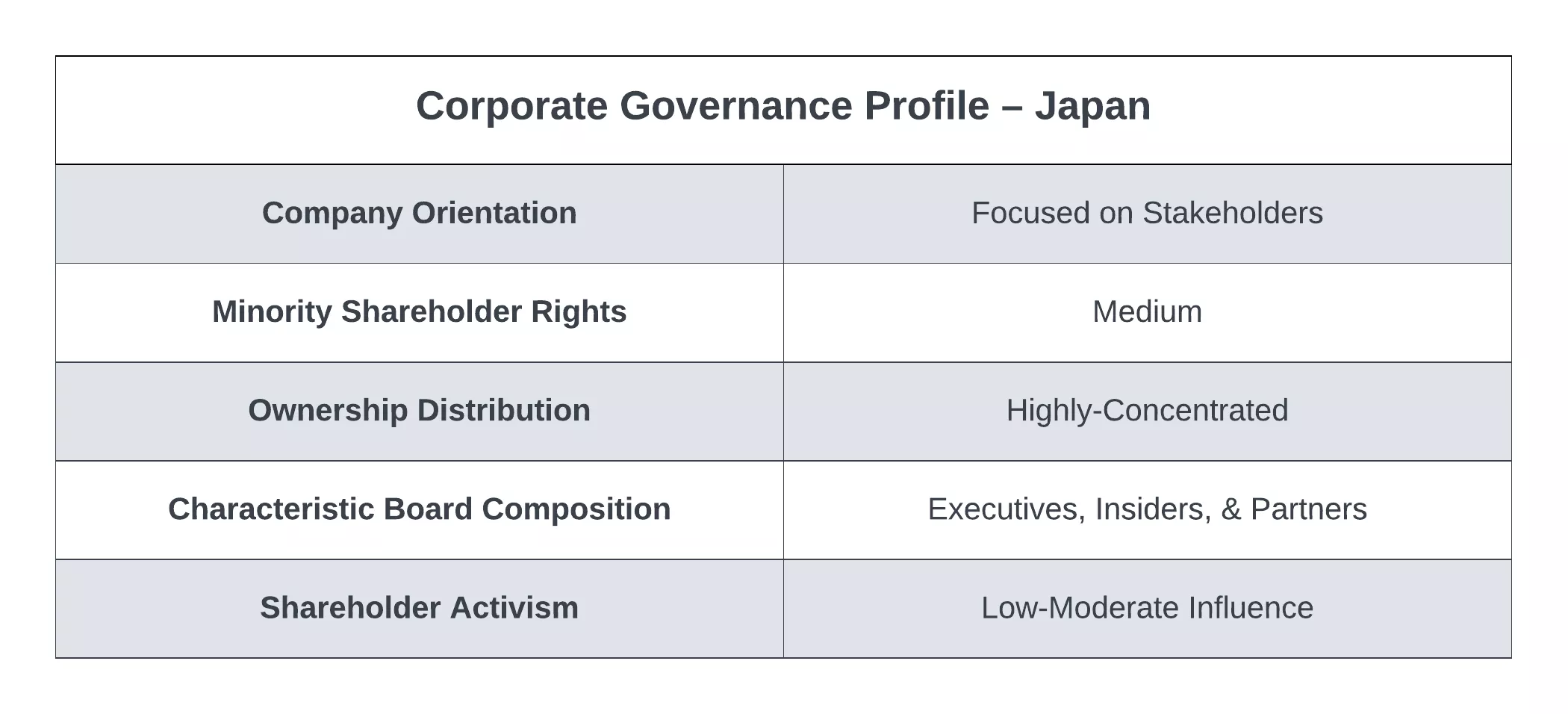
Japan's corporate governance model is a unique blend of traditional and modern influences. With roots in its historical keiretsu system, Japan's corporate governance model is evolving under new regulations, pushing for improved transparency, diversity, and increased shareholder rights.
Operating under a civil law system, Japan's corporate governance is primarily guided by the Companies Act and the Financial Instruments and Exchange Act. The Financial Services Agency (FSA) and the Tokyo Stock Exchange (TSE) play critical roles in regulation. For its part, the TSE maintains Japan’s corporate governance code, an influential guide for listed companies. Auditing practices are stringent, with audits required for all public companies. Japanese companies generally follow the Japanese Generally Accepted Accounting Principles (J-GAAP) or International Financial Reporting Standards (IFRS).
Japan offers corporations the choice of three types of board structures: the company with a Board of Company Auditors, the company with an Audit and Supervisory Committee, and the company with Three Committees (Nomination, Audit, and Compensation). More and more companies are moving towards the Three-Committee model, which closely resembles U.S. norms. The roles of Chairman and CEO are usually separate. There is pressure for increased gender diversity on boards, although progress has been slow. Japanese firms are required to provide robust financial disclosures, and there are clear rules for managing conflicts of interest. Companies are even required to file the minutes of their board meetings with Japanese regulators.
While traditionally shareholder rights were somewhat subdued due to cross-shareholding among keiretsu firms, recent reforms have strengthened their powers. Voting rights are often proportional to share ownership, although companies are permitted to issue special share classes. Ownership can be quite concentrated, with banks and holding companies bearing substantial cross-holdings. Shareholder loyalty is high amongst institutional investors, and turnover is distinctively low in Japan. Financial intermediaries and proxy advisors are becoming more influential. The market for corporate control has been historically quite inactive, but it's gradually changing with increased M&A activity. Protection for minority shareholders has also been strengthened in recent reforms.
The Japanese model is highly stakeholder-oriented, placing significant emphasis on employees and business partners. Boards may include professionals and executives from other firms, with the goal of promoting general corporate welfare ahead of shareholder value. Employee representation at the board level is not mandated, but many Japanese firms have a practice of promoting senior executives from within. Executive compensation, while increasing, remains much lower than in Western countries. Shareholder approval is also not considered for executive compensation matters.
China
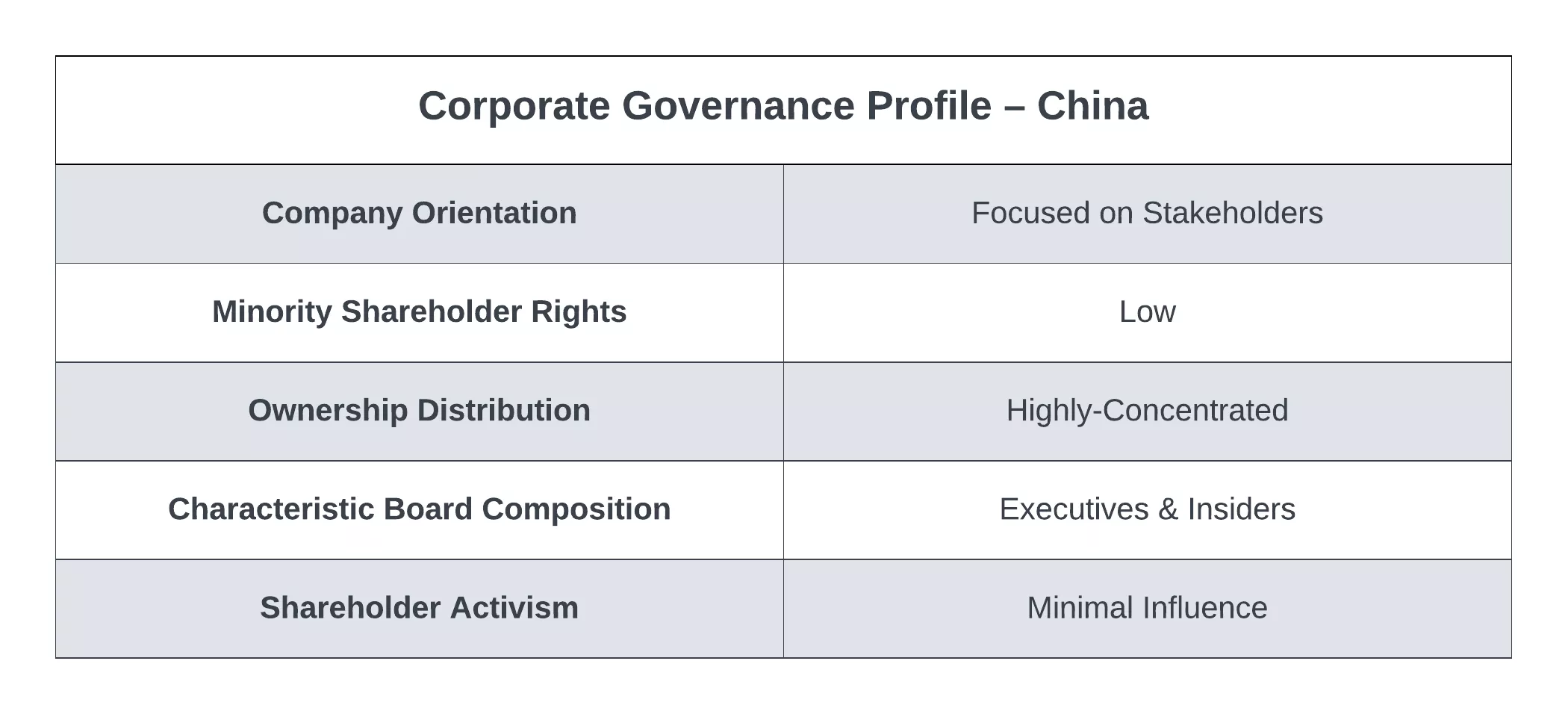
China's corporate governance model is marked by its unique socio-political context and the strong influence of the state. While moving towards globally accepted governance principles, the Chinese model continues to reflect its state-centric approach, with the government playing a significant role in corporate affairs.
China operates under a civil law system. The corporate governance framework is mainly governed by the Company Law and the Securities Law of the People's Republic of China. The China Securities Regulatory Commission (CSRC) is the key regulator for listed companies, and it publishes the Corporate Governance of Listed Companies in China. Auditing is mandatory for public companies, and the Chinese accounting standards are converging towards International Financial Reporting Standards (IFRS).
Chinese corporations (companies limited by shares) typically operate with a two-tier board system, with a separate board of supervisors providing oversight. While there has been movement towards separating the roles of the Chairman and the CEO, in many state-owned enterprises (SOEs), the positions are still combined. Board diversity is gradually gaining attention but is not mandated. Companies are required to provide detailed financial disclosures, with an increasing emphasis on improving transparency.
While shareholder rights are formally recognized in China's Company Law, the state's significant presence in the economy can often override these rights in practice. Voting rights are generally proportional to ownership, but the majority of large corporations are either state-owned or have a state entity as a significant shareholder. Over 90% of exchange-listed companies in China have a controlling shareholder, leaving less room for dynamic activism by other investors. The role of financial intermediaries and proxy advisors remains less influential than in Western models. The market for corporate control is largely influenced by the state, with M&A activity often guided by government policy rather than purely economic considerations.
The Chinese model traditionally has a stakeholder-oriented approach, with significant emphasis on employees and other societal interests. Employee representation at the board level is mandatory for SOEs. Executive compensation is often lower than global levels, but has been rising over the years. Consumer rights have been steadily improving, and privacy regulations have been recently updated to reflect the growing digital economy, resulting in new data protection laws.
Conclusion
Corporate governance practices significantly differ among various countries, driven by historical, legal, and cultural factors. From the strong shareholder focus in the U.S. and the U.K., to the worker participation in board matters in Germany and France, and the influence of state ownership in China, these models reflect the unique business and societal norms of their respective jurisdictions.
Distinctions in board structures, shareholder voting rights, and corporate transparency norms are particularly important for those engaging in international business or foreign investment. The effectiveness of each system offers valuable insights that may inform improvements and regulatory changes worldwide.
References
- Reuters – Overview of Germany Governance
- Hengeler – Corporate Governance in Germany
- The French Model
- Glass Lewis – France Guidelines
- Reuters – Overview of French M&A
- ICLG – Swiss Corporate Governance
- Reuters – Governance and Director Duties in Japan
- Minority Shareholder Rights in Japan
- Comparing Corporate Governance in the U.S. and Japan
- DLA Piper – Chinese Forms of Entity
- Shareholder Rights in China
More By This Author:
American Tower – Beware Storm Clouds On The Horizon
Lessons Learned: Key Takeaways For Investors Following The SVB Collapse
The Limitations Of Passive Investing



